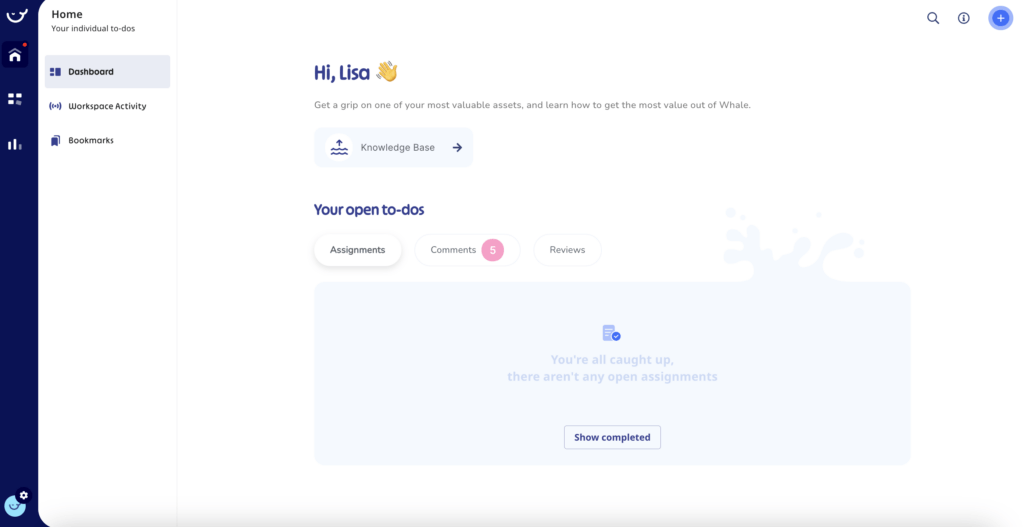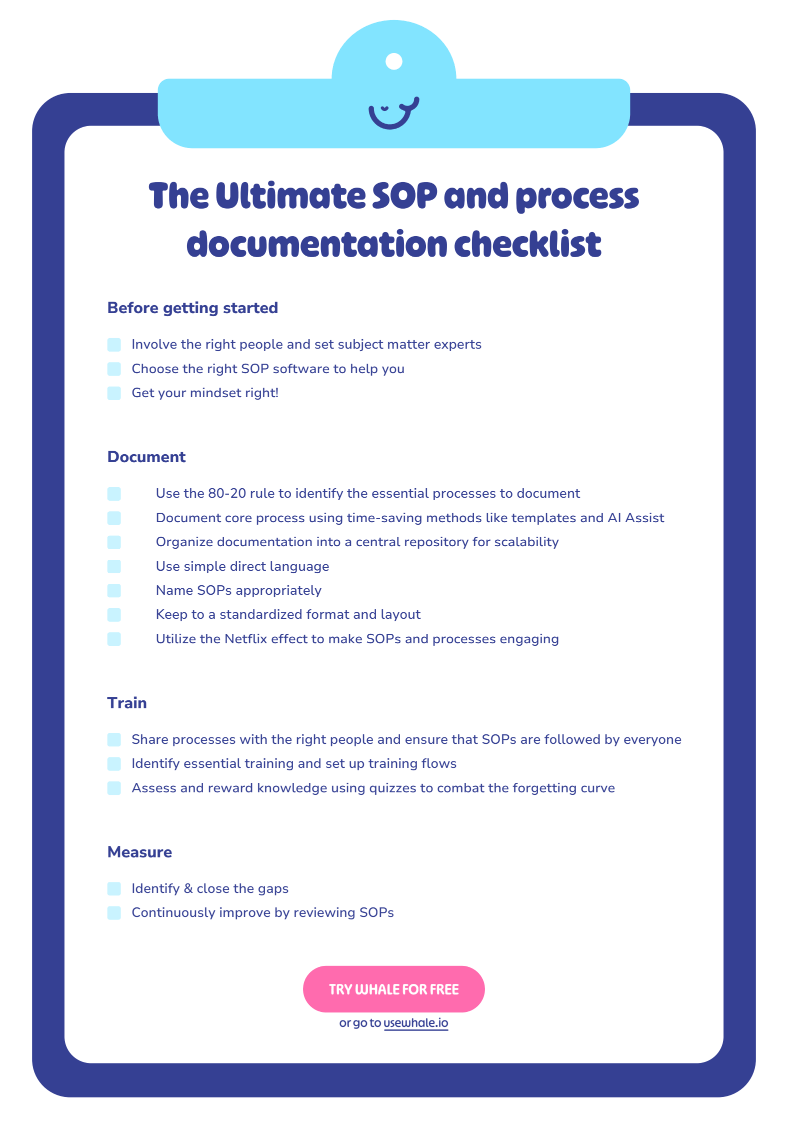Welcome to the Ultimate SOP Checklist
Picture the scene: You’ve spent ages building your organization from the ground up, growing your team and seeing great success. From the outside it may look like a well-oiled machine, with everything working in harmony to get great results. But on the inside, it’s a jumbled-up mess of systems, processes and procedures that leave a lot to be desired.
So, how do you go about fixing this? What you need are some slick new standard operating procedures. Great! But how do you actually go about getting these in place? You’re about to find out.
What is an SOP and why do you need them?
SOPs are the backbone of organizational efficiency, functioning as a structured framework that outlines the precise steps and protocols essential for the seamless execution of business operations. Picture SOPs as the script of a theatrical performance, where each member of the cast understands their role and the choreography required for a flawless production.
Not only do these procedures help to cultivate operational efficiency, but they can also mitigate the risks associated with human error. SOPs are instrumental in onboarding new team members, furnishing them with a structured resource that expedites the learning curve and fosters a rapid assimilation of organizational protocols.
By providing a standardized set of guidelines, SOPs empower teams to consistently deliver high-quality outputs, aligning the organization’s objectives with a predetermined and refined methodology. They’re there to save us all from those awkward “oops, I did it again” moments.

They’re not just regulatory documents; they are strategic assets that fortify organizational structure, enhance operational proficiency, and foster a culture of responsibility.
Embracing SOPs is the key to turning your business into a powerhouse – strong, flexible and ready for anything!
What is a SOP checklist?
Imagine an SOP checklist as your trusty sidekick, making sure everyone follows the rules and gets things right. It’s like a cheat sheet for checking if tasks or activities match what the SOP says.
This checklist is a handy list of things to do, check, or jot down as you work through the SOP. It’s not just a random list – it’s your buddy for keeping things top-notch in terms of quality, productivity, and making fewer mistakes. The checklist keeps everything on the straight and narrow, making sure everyone does their part. It’s also a quick reference for managers or auditors to double-check if everything’s on track. Think of it as your friendly guide to SOP success.
Do you want to make sure your SOPs are in tip-top shape and full to the brim with useful AND useable information for your team? Look no further! Our Ultimate SOP Checklist covers everything from getting started, through to BAU health checks.
What you’ll find inside
Does the thought of documenting your processes fill you with dread?
Don’t panic!
Our Ultimate SOP Checklist includes:
- How to get started, including our top trick for identifying the most important processes to document
- How to make sure your SOPs are effective and useful for your team
- How to measure the success of your SOPs and ensure continuous improvement
Are you freaking out about the amount of processes and procedures in your business and want to get everything documented in one place?
Our Ultimate SOP Checklist gives you absolutely everything you need to get your SOPs in ship-shape order. So take a deep breath and let’s get going (we promise it’s easier than you think!)
And we’ve broken it up into 4 simple sections
Getting started with SOPs ✅
Involve the right people
Now, you may be tempted to start completing this whole process on your own. But let us stop you there. If you want SOPs that are documented right the first time, your best option is to bring in the subject matter experts. And by this, we mean the people who carry out the processes on a regular basis.
They’ll know the ins and outs, the ups and downs. They’re ideally placed to get all the information out of their heads and into a neat and tidy SOP ready for the rest of the business to learn from.
Choose the right SOP software
The whole point of creating SOPs is to bring everyone together onto the same page and make your working lives easier. This is where technology is your friend!
At Whale, we have all the tools you need to create your SOP and process documentation, centralizing them in a single source of truth. Find out more about how it works.
Get your mindset right!
In order to write an SOP, you must think like an SOP.
Ok, we’re only kidding.
But you do have to get yourself into the right mindset to be able to write them effectively.
You’re going to need a combination of focus, organization and a clear understanding of your objectives. Here are some tips to help you get into the zone:
- Define the purpose and the goals of your SOP and keep these at the front of your mind when you’re writing them.
- Consider who will be reading them and try to personalize the SOP to their specific needs.
- Divide the process into manageable sections.
- Take as many breaks as you need!
Document your SOPs ✅
Use the 80-20 rule
Working out which processes to start documenting isis the first thing that tends to put people off. With so many different options to choose, it’s an overwhelming task knowing where to start. But we’ve got a secret…the 80-20 rule.
This rule – also known as the Pareto Principle – is the idea that roughly 80% of the effects come from 20% of the causes. This basically means that you only need to document about 20% of your processes, because they deliver 80% of the results! Music to your ears.
Start by listing out the processes that are used most in the business. Is it onboarding? Is it events marketing? Is it customer service? Whichever one it is that’ll have the biggest impact, this is the best place to start.
Save time with templates and AI assist
Do not – we repeat – do not spend hours and hours documenting every single detail of a process. We are huge advocates of getting things done as quickly as humanly possible, using shortcuts wherever you can to get your SOPs written up quickly – but also effectively.
At Whale, we have a whole load of pick-and-play SOP and process templates to help you on your journey to success quickly and easily. We also have an integrated AI assist tool that means you can write your SOPs in a matter of seconds!
Not bad, if we do say so ourselves.
Save your SOPs in a central location
There’s absolutely no point in wasting your time creating your amazing SOPs if no one can actually find them. The McKinsey Global Institute (MGI) found that an average team member spends about 20% of their working day searching for the information they need. This equates to a huge $10,000 per year for every employee who earns the average salary! Not something you want to risk.
So, don’t make anyone work for the information they need – the chances are they won’t bother! Put them somewhere central where everyone can find them quickly and easily.
Use simple, direct language when writing SOPs
SOPs serve as crucial guides for people across various roles and backgrounds, from new employees to seasoned professionals. Complex and convoluted language can lead to confusion, misinterpretation, and, ultimately, errors. By adopting a straightforward and clear communication style, SOPs become more accessible and user-friendly, ensuring that everyone, regardless of their level of expertise, can easily understand and follow the outlined procedures.
Use simple, direct language
There are 3 key rules when it comes to naming your SOPs.
- Be specific
- Categorize
- Tag
Think about how people are going to search and find the SOPs – what words will they use? USE THESE! And make sure you always put the most important word right at the start. So instead of calling it:
❌The process for writing and publishing blogs
Just call it
✅Blog process
Keep a standardized format and layout
A consistent structure isn’t just for the neat freaks; it’s for everyone who wants to get things done without scratching their heads. Imagine trying to follow a recipe that keeps changing fonts and styles—it’s a recipe for disaster!
With a standard format, you’re not just making life easier for your team, you’re also making it easier for your future-self when you need to update them (more on that later).
Utilize the ‘Netflix effect’
Let’s preface this point by saying not everyone learns in the same way. Some people can learn a process by reading about it, some people have to do it, others like a mix of both. The important thing is that you enable people to learn your processes and procedures in whatever way works for them.
This is something we call “the Netflix Effect”. Instead of offering boring training sessions and desk-based learning, it’s time to revolutionize these programs with a selection of different resources tailored to their needs and preferences.
Train teams using SOPs ✅
Share your SOPs with the right people
When you’ve written your SOP, it’s time to shout about it! Make sure that anyone and everyone who will find it useful knows that it exists and where to find it. These people will also play a huge part in making sure your SOPs are kept up to date, accurate and relevant.
Set up training flows
There are plenty of people within your business who’ll need to be trained on the SOPs that you’re writing, so it’s a good idea to identify the essential training that will go alongside them.
Once you’ve worked this out, training flows are a great way to make sure that people get all the information they need, in the right order.
Picture it like a dance routine. It guides your team through the beats, ensuring everyone’s on the same rhythm. It’s not about overwhelming them with a marathon of SOPs; it’s about creating a dance floor where each move flows naturally into the next.
A smart training flow guarantees your team doesn’t feel like they’re doing a cha-cha in a tap dance class. It’s the key to transforming your SOP rookies into skilled dancers who know the routine and own that dancefloor.

Reward knowledge
One of the obstacles that you’ll need to overcome is the forgetting curve. Some studies suggest that humans forget approx 50% of new information within an hour of learning it. That goes up to an average of 70% within 24 hours. To combat this, we recommend using continuous reinforcement.
You can use quizzes to:
- Assess knowledge and focus on key areas of learning
- Motivate learning
- Trigger memory recall improving knowledge retention
- Identify knowledge gaps
After all, the more fun they have learning, the more likely they are to retain the knowledge.
Measure SOP impact ✅
Identify & close the gaps
As much as we’d love to tell you that you can create your SOPs once and never look at them again, sadly this isn’t the case. Your processes are going to change, just as your business does.
A great way to make sure you always pick up on any gaps or issues with your SOPs is by creating an open feedback culture with your stakeholders. No matter if they’re employees, customers, or suppliers, their feedback is like gold dust and can make a huge difference to the success of your documentation.
Whether you choose to use surveys, focus groups, interviews or a less formal method, getting that feedback and acting on it it’s vital.
Continuously review your SOPs
Every SOP that you create should go through a periodic review process to make sure it’s still effective and relevant. This should be carried out by the assigned owner, going through a thorough examination of the process and any associated documentation.
As part of the review, they should identify any issues or areas that could be improved, making recommendations for these to be updated. Find out more about how to review your SOPs and company documentation.
Bottom Line
Need a process to document your SOPs? Simply follow the Ultimate SEO checklist as we’ve listed the steps above.
What are you waiting for?
If you don’t have the right tools to get started, simply sign up for a free account on Whale today!





